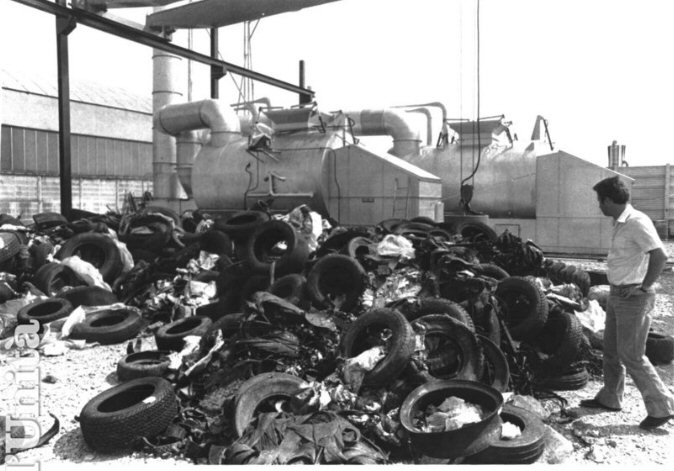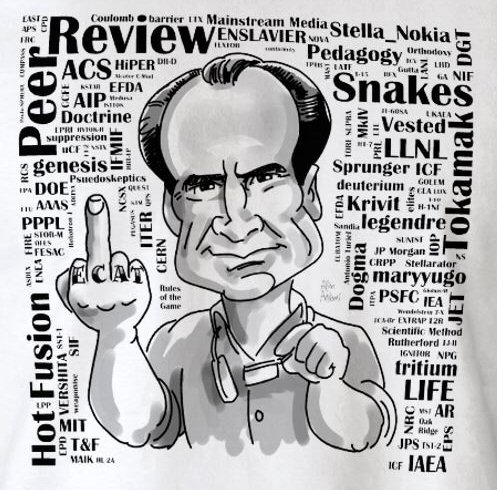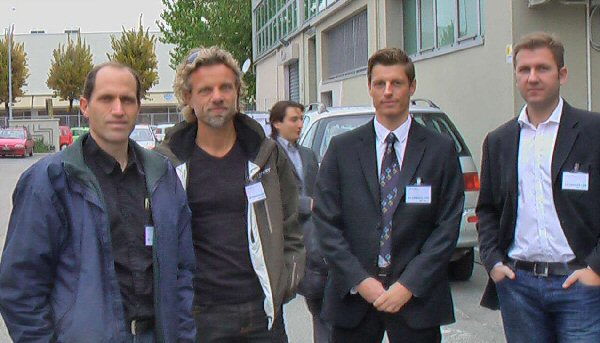Back to Investigation Summary
A six-year retrospective of the Andrea Rossi E-Cat Fraud
By Steven B. Krivit -- Nov. 2, 2016
E-Cat is the nickname for a fraudulent thermal power generation system called the Energy Catalyzer, conceived by white-collar criminal Andrea Rossi. He has served time in prison twice and been convicted of financial fraud. The E-Cat is at least his third energy-related scam.
Rossi's first energy scam took place between 1970 and 1990 when he convinced people that he could convert industrial waste into fuel. Rossi's company produced no fuel. Instead, it created toxic waste and environmental damage by leaching chemicals like dioxin into the land and groundwater in the Milan, Italy, area. Luigi Acerbi, the mayor of Lacchiarelli, Milan, Italy, after seeing Rossi's waste-to-oil scam, told Italian journalists on RAI-TV that he was mystified by Rossi's ability to create an illusion.
"In the years when he was working here," Acerbi said, "Rossi didn't produce a single drop of oil, as far as we know. What he did was just create a media event. He was able to persuade — in a way that I cannot explain — a good portion of public opinion, and that's exactly what is hard for me to explain. He persuaded technicians in the field, scientists and important institutions, in the region of Lombardia that he was able to do magic."

1980s: A pile of used tires and waste in front of Rossi’s Petroldragon machine. Image courtesy L’Unita
More than 100 Italian newspaper articles have published the facts of Rossi's Italian financial and environmental criminal history. After Rossi was released from prison, he began another energy scam, this time convincing the U.S. Army that he could develop thermoelectric devices that had record-breaking efficiency. After the Army funded Rossi, to its dismay, it learned that the devices Rossi promised would provide an output of 800 Watts each produced only 1 Watt.
In 2011, Rossi began promoting his new E-Cat scam. He orchestrated the scheme, one step at a time, by convincing a few scientists who were all too willing to believe that he had developed a ground-breaking LENR (low-energy nuclear reaction) reactor. He claimed that his E-Cat reactor could reliably produce 1 million times more heat output than typical thermal outputs in LENR benchtop experiments. However, he designed his E-Cat systems in ways that made accurate heat measurements very difficult, if not impossible. He never allowed independent parties to have full control of and access to these systems. In all cases, Rossi had a hand in what he and his promoters called "independent" tests of system thermal output.
Longtime LENR researchers who played the most significant roles in promoting Rossi's fraudulent E-Cat were Michael Melich (b. 1940), Edmund Storms (b. 1931), Michael McKubre (b. 1948), David Nagel (b. 1938), Mitchell Swartz (b. ~ 1949), and Mahadeva Srinivasan (b. 1937). Among the credulous promoters was Nobel laureate Brian Josephson (b. 1940). All of them had long careers in legitimate scientific research but became enamored of the erroneous idea of room-temperature "cold fusion." They failed to distinguish that idea from the legitimate non-fusion LENR ideas.
One of Rossi's key collaborators was technology journalist Mats Lewan, writing at the time for the Swedish technology weekly Ny Teknik. Lewan took what Rossi told him on faith, measured data for Rossi on his behalf, then wrote news stories based on his own data. Lewan ignored multiple warning signs about grossly exaggerated excess-heat measurements. Such signs were obvious to many people who read his articles and watched his videos of Rossi. While feeding false hopes to his readers, Lewan ignored Rossi's many factual inconsistencies and overlooked the ever-changing string of unfulfilled promises Rossi made to his fans. A full list of the facts and events are shown in this timeline.
As part of his scheme, Rossi developed an Internet fan club by appealing to hopes and dreams of a better world, powered by clean, cheap fusion energy. At last count, Rossi had exchanged more than 28,500 messages on his blog with his fans. By 2011, like a Pied Piper, Rossi had inspired his fans to create more than 80 Web sites to promote his E-Cat. Many of these sites appeared to be "ghost" sites, filled with content intentionally designed to manipulate Web statistics and search engines. Some of them appeared to be owned by the same people and were tailored to commercial promotion of the E-Cat, advertised as a commercially capable thermal power source. For a while, Rossi kept his fans in a perpetual state of expectation, assuring them that he had proven his E-Cat in the marketplace and that he had sold his "working reactor" to a purported customer.
Beyond the faith of these well-intentioned members of the lay public, he also fueled a more aggressive tribe of coordinated Internet supporters who expressed their discontent with big oil, peer review, conventional fusion research, and anyone who publicly challenged Rossi's exaggerated claims.

T-shirt designed by Rossi supporter Tony McDougall
Another major promoter and business associate of Rossi was Sterling Allan, of Fountain Green, Utah, the creator of Pure Energy News Service and the Free Energy Blog. Sterling's character emerged in February 2016, when he was arrested on multiple counts of child sex abuse, according to the Provo, Utah, Daily Herald. According to the Daily Herald, police reports say that a special agent with the FBI received a tip in January 2015 that Allan was involved in the sexual exploitation of children. Allan is a divorced father of three girls and one boy. Allan admitted in a YouTube video that he had what he called a "predisposition to pedophilia." In 2016 he was convicted and on his way to prison.

Rossi promoters Sterling Allan and Mats Lewan, and two unidentified Swedish visitors outside Rossi's garage, which he called a laboratory, Oct. 28, 2011.
After gaining widespread Internet exposure thanks to Lewan and Allan, Rossi was moderately effective in getting mainstream media attention from Fox News, Wired U.K., Forbes and a few other news outlets. What the Rossi E-Cat story lacked in legitimate science, it made up for in entertainment value. When asked why the big shipping container filled with dozens of foil-wrapped water jugs (that is, his claimed 1 MW thermal E-Cat reactor) was still sitting in his garage months after he told fans that it had been sold and delivered to the "customer," Rossi gave a superficial explanation that there had been a problem with gaskets. When asked why he told people that the E-Cat had been delivered when it hadn't, he said that there had been a "translation error" in what he had initially told his fans.
The E-Cat phenomenon garnered a fair share of satire on the Internet, but the widespread repercussions were damaging to the LENR field. In 2012, the commander of the U.S. Navy's Space and Naval Warfare Systems Center in San Diego shut down LENR research at the base after Fox News published a false association of the SPAWAR researchers with Rossi.
By 2012, Paul Burns, the publisher of one popular Rossi fan site, ecatnews.com, began to see the extent of the scam. "Even his supporters admit he lies as they excuse him for one reason or another," Burns wrote. Burns warned his readers on Nov. 2, 2012, in a post title "The LieCat," that Andrea Rossi was acting like a fraudster. (PDF)
"Each time some deadline approaches," Burns wrote, "Rossi changes tack, often making ever ‐ increasing outlandish claims that have become tiringly predictable. The man is a liar, and if you give him money on the strength of his word, you are more trusting than me. ... You have been warned."
One company failed to heed Burns' warning. Rossi gained the confidence of Thomas Darden, the founder and chief executive officer of the $2 billion private equity fund Cherokee Investment Partners. Darden, in turn, gained the confidence of 13 investors, formed a new company called Industrial Heat, and began promoting Rossi's E-Cat. Darden and his investors agreed to purchase the dubious E-Cat system for $100 million.
In serious conflict with sound business practice, Darden trusted Rossi to conduct the first round of technical due diligence on behalf of Industrial Heat. Rossi walked away with $11 million and quickly purchased the equivalent amount of commercial real estate in Miami Beach, Florida. Before the outstanding $89 million transaction could be completed, both parties sued each other for fraud.
After these lawsuits became public, room-temperature-fusion-believing researchers turned on Rossi and, like "FredZ777" wrote on ecatnews.com, fled "like rats deserting a sinking ship." Edmund Storms rationalized that "naturally, some exaggeration, fraud, and lying would be involved because people do not like to give money without knowing the secret, which cannot be revealed." Michael McKubre resigned from SRI International and moved back to his native country of New Zealand, while Brian Josephson continued to defend the fraudulent excess-heat claims of Rossi.
After Burns shut down eCatNews, E-CatWorld.com remained (and remains) the last major Internet watering hole for Rossi believers. The Web site is maintained by Frank Acland, a science fiction and fantasy writer, and whose business affiliation with Rossi is unknown. This page lists all the key players and promoters of Andrea Rossi's fraudulent E-Cat scam.

Frank Acland,
publisher of
E-CatWorld.com and promoter of E-Cat scam |
Ackland's faith in Rossi is based on his confidence in the judiciousness of two Italian scientists, Sergio Focardi and Giuseppe Levi, and two Swedish scientists, Sven Kullander and Hanno Essen.
"I don’t see any way that Rossi could have hoodwinked these professors with some kind of rigged machine," Acland wrote.
Rossi's first trick was simple: He dumped hot water down a hole in the wall. Through carefully conceived methods of distraction, obfuscation, and lies about power measurements, he convinced the four professors — who didn't know the kind of man they were up against — to take him at his word that all the water had been turned into steam. Acland also based his faith on the false belief that Rossi was not trying to defraud people.
"There has been no appeal for the public to send him money," Acland wrote, "and no one has come forward and said that Rossi has tried to defraud them. ... The Cherokee/Industrial Heat connection is an indication that serious professionals have done due diligence into Andrea Rossi’s work and have been convinced that the E-Cat is a technology worth investing in."
|
Acland's defense of his support of Rossi, of course, is five years out of date. (PDF) Not only did Rossi take $11 million from Industrial Heat and employ his own engineers for Industrial Heat's due diligence tests, but in 2011 he also demanded that multiple parties, including NASA, pay him large sums of money for the privilege of taking a close look at his E-Cat device.
Bob Tinvan, a faithful Rossi supporter, wrote on Acland's Web site that he couldn't imagine the unimaginable. "It seems unrealistic that Rossi could be weaving such an enormous web of lies: He would have to be a brilliant psychopath to perpetuate the story for so many years."
That is precisely the analysis of potential investor Brian Scanlan, who met Rossi and Darden at a meeting arranged by Michael Melich and Marianne Macy. (PDF) The husband-and-wife team of Melich and Macy was the first Rossi promoter in the LENR community. They strongly encouraged members of the LENR community to support Rossi and the E-Cat idea; Melich compared Rossi to inventor Nikola Tesla. Scanlan eventually saw through the smoke.
"Take a look at "How to Spot a Sociopath," Scanlan wrote. "Most of us in this group have trouble with the basic questions, 'Why would Rossi try to pull such a brazen fraud? How did he expect to get away with it?' Answer -- Some people crave control. For some, control is much more important than money. And Rossi has succeeded. He's hijacked the LENR agenda, which has derailed countless sincere and promising research efforts. Folks, it's time to move on."
Another answer is that Rossi has figured out how to make a profit from energy scams and mostly stay out of prison. Readers who have been following New Energy Times since 2011 have known for five years that Rossi's E-Cat was a scam. In June 2011, I went to Italy and interviewed Rossi and filmed a demonstration of his copper-pipe E-Cat contraption. I also interviewed Focardi and Levi. Twenty-four hours later, I reported serious concerns about whether Rossi was accurately measuring the E-Cat's heat output. Six days later, I posted my video on YouTube, which cast serious doubt on Rossi's claims.
Experts from around the world sent me technical and engineering analyses. In July 2011, I published their reports in a comprehensive 200-page report. At that point, it was already obvious that Rossi's E-Cat power system was a fraud.
The full story is here.
|